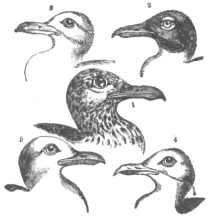GUN 814 GUN
Description
This page of the book is from "The New Student's Reference Work: Volume 2" by Chandler B. Beach, Frank Morton McMurry and others.
GUN
814
GUN
and, along the coast, on mollusks, the shells of which are broken by being carried to a height and allowed to fall. The common gull of North America is the herring-gull, abundant in bays and harbors, seen far at sea and also ranging far inland. Its winter home is in the United States; it nests from southern Maine to the Arctic Ocean. The common terns, frequently seen on Lake Michigan and the other Great Lakes, are

HEADS OF GULLS
(1) Great black-backed. (2) Black-headed.
(3) Killiwake. (4) Small black-backed.
(5) Herring-gull.
most graceful birds in flight, and are often called sea-swallows. They are more slender than gulls, and have long forked tails and slender bills. These beautiful birds have been destroyed in immense numbers for trimming ladies' hats, but a crusade has been effectively waged against the wanton destruction and the birds are being saved from extermination. See Terns.
Gun, a term often used to describe all firearms and still applied to cannon and other large artillery, though strictly it is limited to the sporting-gun or modern shotgun. The early firearms brought into use by the invention of gunpowder were known under different names; as "bombards" in Italy, "crackeys" in England, etc. In the 15 th century they began to be grouped in classes. Bombards were short vessels from which stone balls were shot, and were the forerunners of the present bombs and mortars. Cannon were not much larger than the muskets of the 18th century. Culverins were cannon, and fired stone, shot, iron and leaden balls; these were used in England until after the Commonwealth. There also were hand-culverins used on horseback, weighing about 15 pounds, and some weighing 60 pounds were used by foot-soldiers. The "culver-ineer" needed a servant to help him to fire it, as the gun was supported on a forked rest. He had to carry, besides the gun, a flask
of coarse powder for loading, one of fine powder for priming, a bag of bullets, a musket rest and a burning match. From improvements in the culverin the matchlock was developed, with its varieties of arquebus, hackbutt and musket. These early firearms were loaded with difficulty, as they had to be placed on the forked rest attached to the gunner's wrist, and the match, a slow-burning fuse, gave a great deal of trouble in damp weather. In a battle in 1638 the musketeers fired only seven shots in eight hours. The firelock or flintlock, with its new method of firing, was introduced in Spain about 1625, and is said to have been the invention of highwaymen, as the burning match dangerously betrayed their presence. It was used in the English army from about 1688 to 1840. The first pistols were made in 1540, and were first used as concealed weapons. Double and four-barreled pistols were common in the 18th century, and the revolving . pistol, called the "pepper-box," preceded the modern revolver. About 1890 it began to look as if an automatic pistol would replace even the seven-cartridge revolver. The best known sorts are the Burchardt-Luger, Colt, Männlicher and Mauser. The gas made by firing operates the mechanism. It opens the breech, extracts and expels the cartridge, and reloads and recloses the breech. The man merely refills the chamber and pulls the trigger. The Burchardt fires 48 shots in 28 seconds. But a revolver has been invented that almost equals an automatic pistol in rapidity of fire, and also uses regular ammunition. The shotgun or sporting rifle is carried to the greatest perfection in England. The range is about 45 yards, and the shot will strike a target 120 feet distant in thirteen hundredths of a second after pulling the trigger. Smokeless powder is used in these guns. The finest shotguns, made by the best-known gunsmiths, are valued at $200 apiece. The introduction of smokeless powder opened a new era. The newest model of the United States Springfield rifle surpasses that of 1892. It has a magazine, like a box, that is situated under the receiver. The cartridges are loaded from a clip. Twenty shots have been fired in 28f seconds. The bullet travels 2,300 feet a second, penetrating 42 feet of white pine, and the range is five miles. The new Springfield is almost one tenth faster than the old one, and nearly one fifth more accurate. Its only equal is the 1903 Mauser. Some armies are replacing their magazine-rifles with automatic rifles. The Wood gate automatic rifle holds 20 cartridges, fires 200 rounds a minute, and can be fitted to old makes. The Maxim automatic, firing 600 rounds per minute, is a notable machine gun: the one-pounder Maxim-Nordenfeldt (automatic) gun was in use in the Spanish-American War and


